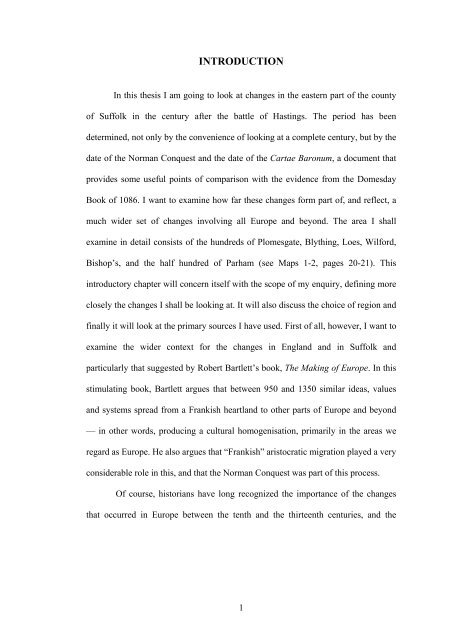I certify that I have read this thesis and have ... - Bilkent University
I certify that I have read this thesis and have ... - Bilkent University
I certify that I have read this thesis and have ... - Bilkent University
You also want an ePaper? Increase the reach of your titles
YUMPU automatically turns print PDFs into web optimized ePapers that Google loves.
INTRODUCTION<br />
In <strong>this</strong> <strong>thesis</strong> I am going to look at changes in the eastern part of the county<br />
of Suffolk in the century after the battle of Hastings. The period has been<br />
determined, not only by the convenience of looking at a complete century, but by the<br />
date of the Norman Conquest <strong>and</strong> the date of the Cartae Baronum, a document <strong>that</strong><br />
provides some useful points of comparison with the evidence from the Domesday<br />
Book of 1086. I want to examine how far these changes form part of, <strong>and</strong> reflect, a<br />
much wider set of changes involving all Europe <strong>and</strong> beyond. The area I shall<br />
examine in detail consists of the hundreds of Plomesgate, Blything, Loes, Wilford,<br />
Bishop’s, <strong>and</strong> the half hundred of Parham (see Maps 1-2, pages 20-21). This<br />
introductory chapter will concern itself with the scope of my enquiry, defining more<br />
closely the changes I shall be looking at. It will also discuss the choice of region <strong>and</strong><br />
finally it will look at the primary sources I <strong>have</strong> used. First of all, however, I want to<br />
examine the wider context for the changes in Engl<strong>and</strong> <strong>and</strong> in Suffolk <strong>and</strong><br />
particularly <strong>that</strong> suggested by Robert Bartlett’s book, The Making of Europe. In <strong>this</strong><br />
stimulating book, Bartlett argues <strong>that</strong> between 950 <strong>and</strong> 1350 similar ideas, values<br />
<strong>and</strong> systems sp<strong>read</strong> from a Frankish heartl<strong>and</strong> to other parts of Europe <strong>and</strong> beyond<br />
— in other words, producing a cultural homogenisation, primarily in the areas we<br />
regard as Europe. He also argues <strong>that</strong> “Frankish” aristocratic migration played a very<br />
considerable role in <strong>this</strong>, <strong>and</strong> <strong>that</strong> the Norman Conquest was part of <strong>this</strong> process.<br />
Of course, historians <strong>have</strong> long recognized the importance of the changes<br />
<strong>that</strong> occurred in Europe between the tenth <strong>and</strong> the thirteenth centuries, <strong>and</strong> the<br />
1
















